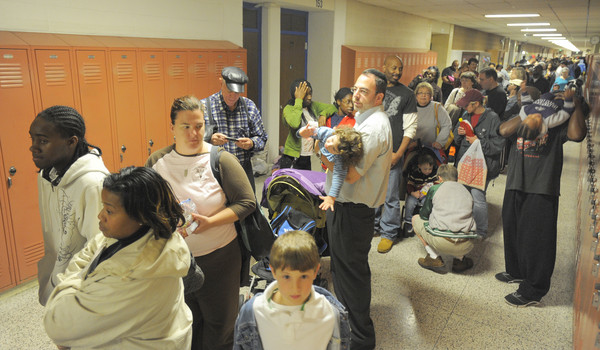Underachieving virus, mixed Federal messages contribute to H1N1 swine flu vaccine debacle
In yesterday's blog, I mentioned what I thought were the root causes of the H1N1v vaccine shortage/delay situation.
So as I always try to do, I reached out to an expert to get his opinion and bounce theories off of him. In this case, the expert is one of the top scientists in the field of vaccine research: Dr. Greg Poland of the Mayo Clinic.
His introductory paragraph from the Mayo Clinic Website states:
 Vaccine-preventable infectious diseases; vaccines against agents of bioterrorism; predictors of vaccine response; antigen processing and HLA presentation; vaccine immunogenetics; cancer vaccines.
Vaccine-preventable infectious diseases; vaccines against agents of bioterrorism; predictors of vaccine response; antigen processing and HLA presentation; vaccine immunogenetics; cancer vaccines.
I have been seeking Dr. Poland's counsel for several years, and he has always proven himself to be receptive, affable, and eager to contribute. He is, in short, a great guy, though I have never met him. I feel as though I have, and one day I shall.
Anyway, Dr. Poland concurred with my belief that the two major factors that have contributed to the delays are a low-yield, difficult-to-grow virus; plus an "overly optimistic" Federal government spin on the vaccine situation.
While the early stages of this pandemic were managed according to the Bush playbook, authored by then-CDC head Dr. Julie Gerberding and then-HHS Secretary Mike Leavitt, this is now Obama's pandemic to manage. And the setbacks and mixed risk communications are becoming apparent.
The vaccine is no longer "early." In fact, by this time in Florida alone, there should have been some 3.787 million doses of H1N1 vaccine shipped to providers in-state. That is what was promised to the State of Florida back in September. Most of those shots would have gone directly to the "FloridaShots" network of 3,000+ health care providers and counth health departments.
But instead, Florida has only received some 900,000 doses of vaccine, a combination of FluMist and injectable vaccine. This is not even 25% of the doses promised by the Feds.
Likewise, back in September, the Feds had told the states there would be some 63.8 million doses of vaccine available by the end of October. Now, Washington is saying they will be lucky to deliver 28 million doses, or roughly 44% of the originally-promised total.
What, you say? the Feds promised 63.8 million doses? The media are reporting it was only 40 million! Wrong, swine breath. The original early September figure for planning purposes was 63.8 million doses nationwide. The Feds revised that 63.8 million figure downward to 40 million, then downward again to 28 million.
And in order for Washington to even keep that promise, it would have to send Florida 780,000 doses of vaccine within the next three days. Now how likely is that? I am not holding my breath. Nor should you.
Florida, instead of being promised 3.787 million doses of vaccine by the end of October, is now promised 5 million doses by the end of December.
 State and county health departments have been working 24/7 since August, planning and planning and planning some more for clinics that have been cancelled, postponed, rescheduled and then postponed yet again as the vaccine numbers slip. This is absolutely not their fault. Fortunately, some vaccine clinics have been successful, if running out of vaccine within 70 minutes (like they did in Baltimore recently, see photo above) can be considered successful.
State and county health departments have been working 24/7 since August, planning and planning and planning some more for clinics that have been cancelled, postponed, rescheduled and then postponed yet again as the vaccine numbers slip. This is absolutely not their fault. Fortunately, some vaccine clinics have been successful, if running out of vaccine within 70 minutes (like they did in Baltimore recently, see photo above) can be considered successful.
State and county health departments are tired, frustrated and just want consistent information that they can use to make sound plans. They do not need inaccurate promises of vaccine deliveries to make their dire situations even worse.
And in some cities, such as Los Angeles, health authorities are catching flak for inoculating anyone who showed up -- even if they were not in the target groups for vaccine. What is equally interesting about the LA experience is that the private providers are all out of vaccine, and the free clinics are the only ones with vaccine to give. So the persons in the target groups who had been waiting for their private doctor to administer the shot found out they were out of luck, so they opted for the public option, so to speak. It asks the question about whether or not the distribution of vaccine amongst private and public providers, especially in California, is an equitable and fair one.
So let's recap: We have insufficient vaccine, which is the fault of the virus itself for not growing rapidly enough in labs to produce sufficient amounts of vaccine. Damned underachieving virus! Additionally, the seed stock of virus, even after being turbocharged by the CDC and others, simply did not respond well enough to grow quickly.
The Federal government knew this back in the summer, and that was dutifully reported here at this blogsite and in the blogosphere and sometimes in the mainstream media. Nonetheless, when the vaccine makers said they could deliver vaccine earlier than expected, the Administration chose to trumpet this to the press, which dutifully reported it to the American people (and as I did and others in the blogosphere). Unfortunately, the Administration did not choose to "trust but verify," as a great president once recommended, and now it is trying to distance itself from a problem of its own exacerbation by making claims, as HHS Secretary Sibelius said this week, that there would be "an ample supply" of vaccine.
Really? When?
Is it any wonder that the Obama Administration just declared a national emergency over swine flu? Perhaps they are reading the tea leaves, as I am reading them. Here's what I see.
We are going to have a nasty winter. No, we're going to have a milder winter. That depends on what our old buddy El Nino does. For the mid-Atlantic states south, it means colder and wetter winter. Imagine a line from northern Virginia west to the Texas Panhandle, south to Lubbockand southeast to Key West. Cold, wet and generally crappy winter is forecast within that area. Maybe the rest of the nation, too, if the El Nino is weak, as some are beginning to forecast.
Couple this coming winter's uncertainty with the absolute certainty that vaccine will be in short supply until Christmastime, and you have perfect conditions for a return of H1N1v as soon as temperatures drop to regular winter levels. The sad fact is that we have lost the ability to vaccinate in sufficient numbers in time for the arrival of winter.
Add in the fact that people outside of the target groups are demanding and getting vaccine, means that those who really need it may be forced to stand in line and wait. And wait.
The Administration's declaration opens up the financial pipeline for Federal reimbursement for costs of triage centers set up far away from the hospitals that they might be connected to. That tells me that this Administration thinks things will get much, much worse before they get better; that the prevailing (yet hushed) talk in DC and elsewhere is of a virus that is poised to strike like a rattler once temperatures stay low and the heart of winter sets in.
Now add in the shortage of vaccine, and you have what many of us have predicted for years: A flu pandemic where vaccine was not readily available until well into the second wave of the pandemic.
Why anyone would have not stayed "on message" regarding this vaccine scenario is beyond me. As Karl Malden's Omar Bradley said to George C. Scott's Patton: "Well, I would give myself a little leeway if I were you."
A new question I now have is this: Can we still trust that one shot will provide sufficient protection? After all, the virus is growing slowly and underperforming. There is tremendous pressure to deliver vaccine at any cost. Are we testing to ensure the vaccine is as potent as promised?
Anyone have an answer?

Reader Comments (3)
First I really like your blog, It has so much information. The Mayo Clinic is such a good place to get information from, I believe what your blog says, but as soon as you add the Mayo Clinic in there it becomes basically a fact. Please email me I actually know of another website that has great information. Thank you.
Nicely put.
Another aspect of the overly-optimistic projections on vaccines is that little has been done to prepare the public for community-level public health interventions that could slow spread of the disease until the vaccine is ready.
No-one wanted to talk about these type of interventions (such as closures, control of gatherings, social distancing, etc.). The result is that it would now be very difficult to prepare people for doing these things at the community-level without an enormous loss of public confidence in whether public health knows that it is doing, and can be trusted to level with the public.
This is a the worst case of of ill-advised risk communications I've sen, where poor communications renders a potentially important public health intervention difficult, if not impossible, to implement.
(Good blog!)
- V
I know many who decided NOT to get the H1N1 vaccine. I know people who have injured or died because of vaccines. The reports in the NVIC database and others are true. I read from Barbara Loe Fisher that nearly half of the public decided not to get vaccinated for H1N1.
I also beleive that Vaccines are not 100% effective. I cannot trust that the shot will immunize everyone, and more importantly, some people beleive peoples immune systems are stronger if they have to fight a diease. Many people with H1N1 survive, too.
I also disagree that social distancing and quaratine will be effective at stopping the spread, too.